In the life of each owner of his own house or who wants to acquire it, sooner or later the question arises: “How to cover the roof?”. The types of roofing materials on the construction market and their abundance amaze the imagination of even the most sophisticated designers. That is why it is important to know some nuances and secrets, so that after the completion of construction work there is no excruciatingly sorry for the lost time and mistakes that would have to be corrected.
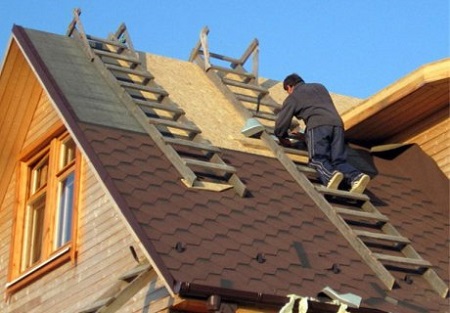
In general, roofing materials are building materials that must be waterproof and meet the technical requirements for strength, frost resistance, deformability, heat resistance and water absorption, flexibility and brittleness, chemical resistance and other characteristics.
Do not forget that the roof plays a very important role, because it performs the following functions:
- protection of the house from external mechanical influences;
- determination of the appearance of the house;
- sound insulation (for example, from rain);
- protection of the house from sunshine;
- the ability to "breathe."
Currently, there are many types of roofing materials. We will consider the main of them, as well as the principles and rules for their correct choice, because it cannot be said unequivocally that this material is bad, and the other is good. Each type of structure requires a special type of material.
Before choosing materials for the roof of the house, pay attention to the following points:
- Possible loads on the roof. Before choosing a roofing material for roofs, consider the own weight of the roof structure, which includes the weight of the roof itself, insulation, battens, rafters, etc. Pay attention to the normative snow cover in your area, as well as the wind strength that is typical for this area.
- The architectural solution of the roof. Forms, dimensions, design features of the building - all this affects the right choice in the matter of roofing roofing materials, as well as the design of the roofing system and its coating. Example: to cover a ceramic tile with a technology, a special degree slope must be observed. So before choosing and buying, carefully consider the outline design and consult with the designer.
- Fire resistance and durability. These characteristics depend on the functional purpose of the structure. For example, it does not make sense to buy technological and expensive roofing materials for a household shed, but you can pay a large amount to cover a house where you will live with your family.
- Warranty period. When purchasing, take an interest in the warranty period for the roofing materials you purchase and compare them with the period of operation that you need. For example, ceramic tiles will serve you much longer than the so-called slate. And in terms of quality, they will vary significantly.
Let's look at the standard warranty periods for different roofing materials (do not forget that the warranty period takes into account the mandatory implementation of installation technology, as well as the operation of the roof):
- Soft tile. Warranty period is 15 - 20 years. Warranty for tightness and absence of factory defects. The warranty does not apply to tile color.
- Metal tile. Warranty period is 5-15 years. Warranty depends on the type of polymer coating. The warranty does not cover discoloration, uniform discoloration and discoloration of the coating.
- Natural tile. Warranty period is 20-30 years. Additional guarantee for frost resistance.The warranty does not cover in case of improper transportation and in case of exposure to acid and vapors.
- Slate. Warranty period up to 10 years.
- Bituminous wavy sheets. Warranty period of 15 years. Guaranteed tightness of the coating. The warranty does not apply to color and its constancy.
- Roofing steel and decking. Warranty period is 15-20 years. Warranty subject to coverage. The warranty does not apply in case of mechanical damage caused during transportation or installation of the product).
- Slate roofs. Warranty period is 30-40 years.
- Seam roofs of 15-20 years.

The service life of some materials significantly exceeds the warranty.
Let's get acquainted with the average durability of roofing materials:
- Soft tile. Durability 30 - 50 years.
- Metal tile. Durability 30-50 years,
- Natural tile. Durability of 100-150 years.
- Slate. Durability up to 30-40 years.
- Bituminous wavy sheets. Durability up to 15-25 years.
- Decking and roofing steel. Durability up to 50 years.
- Slate roofs. Durability 150-200 years.
- Recessed roofs. Durability up to 50 years.

In most cases, do not chase too expensive materials, at the same time, really evaluate the quality of cheap ones. Determine for yourself what characteristics of the roof you need and for what purpose. Try to find a middle ground in the combination of price / quality. Do not overestimate the new materials that sellers praise so much. Balance your financial capabilities and the required quality of the roof.
Content
What are the characteristics to evaluate roofing material for roofs?
- What the material is made of (do not forget that the substance from which it was made affects your health, as some materials are more natural, while others can emit harmful substances).
- What kinds of material exist. (pay attention to shape, color, etc.).
- Maximum and minimum design slope required for the material.
- Basic laying principles.
- Necessary structural preparation (for example, flooring, roofing, lining).
- The main scope of this particular material (for which buildings use the roof of the roof with this material).
- Advantages and disadvantages of the material for the roof.
- The average cost and its ratio with your financial capabilities.
Classification of materials for the roof according to the form of release of the material:
This classification is one of the broadest and most comprehensive. Before choosing it, you should carefully review it to have a general idea of a future purchase.
- Roll materials - great for covering flat roofs. In this case, they are the undisputed “champions”.
- Sheet materials - quick coverage of large roof areas.
- Small-piece materials –are characterized by durability, prestige and ease of repair, as well as roofs with a complex configuration. Their special difference is the unsurpassed appearance of such a roof.
- Bulk materials - are characterized by ease of application and simplicity of laying, as well as ease of repair, durability and ensuring a seamless coating.
Let's take a closer look at each of the classes and evaluate their advantages and disadvantages, as well as the price relative to other types of materials.
Roll materials
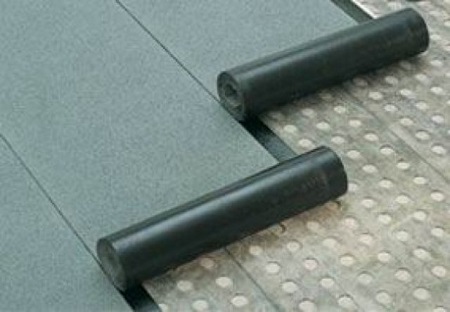
Rolled roofing materials are obtained in two ways. One of them: applying bitumen-polymer or bitumen mastic to one of the foundations. Second: the way of rolling a mixture of mastic with filler (rubber or mineral) and additives (plasticizers, antiseptics, etc.).
All rolled roofing materials also vary in their individual characteristics. Let's take a closer look at each of them.
Classification of roll materials based on:
- Fiberglass. This type of base is one of the cheapest. But do not forget that it is impossible to get high quality at a low price. Most often, glass-based web-based roll materials act as a substrate for other materials (for example, sheet, roll, piece).
- Fiberglass. Such a base is distinguished by very high strength (it surpasses fiberglass by 5 times in strength), but is also three times more expensive.
- Polyester materials. In strength, this base can be compared with fiberglass, but it is much more elastic (elongation is 2-4% for glass materials and 15-20% for polyester), and such material for roofing will have better adhesion to mastic impregnation.
- Cardboard, foil and asbestos paper can also be used as the basis for roll materials.
When laying the deposited materials, they are first laid out 3-5 rolls in a row in parallel, taking into account overlaps of 7-10 cm, then unwound 3-4 m. If the slope is up to 15%, then laying goes along the warehouse, if the slope is greater (up to 25 %), then the laying runs across the ramp.
Laying should begin from the bottom edge, making a lap along the slope. All rolls are rolled up, leaving only the first one and putting it on a special roller. In this case, you should start from the edge of the canvas, warming it with a special heating pad.
In the process of warming up and laying, the canvas must be rolled out with a special roller. The gap when joining the panels along the length should be about 100 mm. The offset when applying the second coating layer should be about 100-200 mm relative to the seams of the first canvas.
Classification of roll materials by type of binder:
- Bitumen.
- Bitumen polymers.
- Polymers
- Tar.
Classification of roll materials by type of protective outer layer:
- Sprinkling with mineral chips.
- Foil.
- Polymer film.
The special characteristics of the protection will ensure a long roofing service, which means savings on repairs.
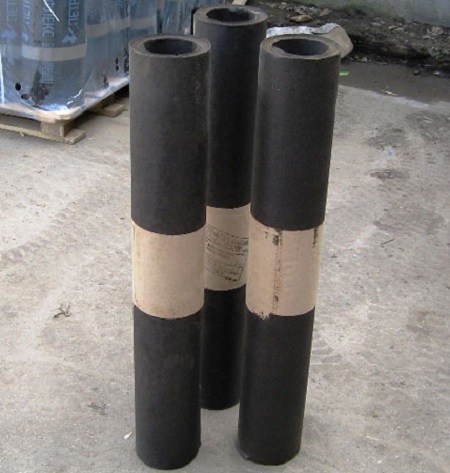
The main popularity in this class was won by roofing material. It is a cardboard that is impregnated with bitumen, an elastic roofing material. A large number of brands and types with differing physical and mechanical properties give room for choice.
The main advantage of the material: low cost. At the same time, it is considered obsolete in the construction services market and is used mainly as an auxiliary material in case of need for waterproofing structures, for other types of coatings.
Also, quite often it is used by housing companies because of the service life of less than 10 years. Repairing with its help multi-storey buildings, they provide themselves with a constant source of income.
New roofing materials based on fiberglass, polyester and non-woven polymer cloth surpass roofing material in practicality and during installation, including the operation of the roof.

Carefully study the composition of the materials, because some are sold with the same composition, but under different names.
When impregnated, the following compounds are distinguished:
- SBS. High elasticity up to -30 degrees. Such material will not harden and break even in winter in severe frosts. This means that the roof will last you an order of magnitude longer. At the same time, materials based on Thermoflex, Bikroelast, Isoelast, etc. They have a low UV resistance, which means they need additional coverage.
- APP. It is characterized by ductility up to -20 degrees and resistance to other types of external influences. The service life of such materials is from 15 to 25 years.

Rolled solutions are the best choice for flat roofs and roofs with a small slope, moreover, at an affordable price.
Sheet materials
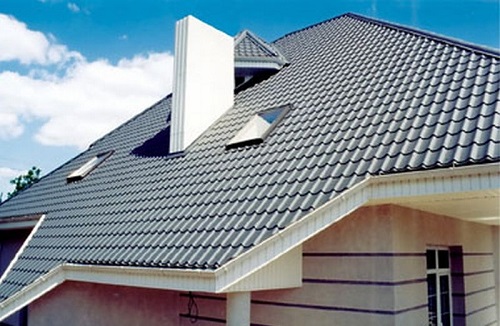
Sheet roofing materials can be called the most extensive class. It is worth paying attention to if the area of the covered roof is very large.
All sheet materials for the roof can be divided into groups according to the substances from which the material itself is made:
- Cement fiber.
- Asbestos cement.
The listed mineral sheet materials for the roof of the house are also called slate. In fact, slate is the German origin of the name of the slate. The difference in the composition and presence of asbestos.
Chemical inertness, strength and relative durability (about 50 years of service), as well as low price and the possibility of easy cutting by a grinder, have become the main advantages of these materials.
Among the shortcomings: fragility and heavy weight, decorative unattractiveness, the harmfulness of asbestos to the human body, the ability to accumulate moisture, due to which the color changes and fungus, as well as moss.
Such material is mainly used for roofs of summer kitchens, sheds, utility units and fences.
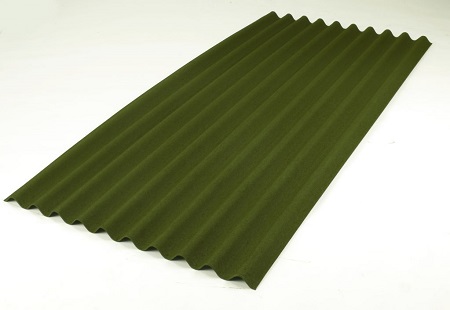
Fibrous materials with such organic impregnation as bitumen, polymers and their mixtures are considered Euro-slate. Their main differences: lightness, durability and high strength (maximum 650 kgf / m2).
Certain species are characterized by a greater or lesser force of resistance to ultraviolet radiation and chemical influences.
Some experts in this group include polyesters. Polyesters are homogeneous polymeric sheets that include the same polycarbonate (one of the transparent roofing materials).
In the construction industry, these roofing materials are becoming increasingly popular. Its main use in this area: covering large public buildings, roofing lanterns and roofs of residential buildings, roofing of winter gardens and greenhouses.
The main differences: strength and cellular structure, which ensures low thermal conductivity. You will remember this more than once in the hot summer days, when the sun will be full, and the room will be cool. The material is quite light and simply bends, so architects can play with the geometry of the roof structure.
- Fiber with polymer-bitumen impregnation.
- Polyesters. In turn, they can be represented by transparent roofing materials.
- Metal. In turn, it can be represented by copper, aluminum and zinc-titanium. It is characterized by ease of installation, high bending strength, durability and relatively low prices. Among the shortcomings are low noise isolation. Most often it is used to cover the roofs of sheds, utility rooms, as well as in industrial construction (roofs of factories, car washes, supermarkets).
- Copper. The main differences: durability (more than 100 years of service), comparative high cost in comparison with other substances, does not burn and does not spread fire, is resistant to acid rains, is not subject to corrosion, environmental cleanliness, and also such a roof does not need special care.
- Aluminum. Main differences: long service life and ease.
- Zinc titanium. The main differences: durability, lightness, lower price than copper, on the roof it looks like copper.

The listed materials are classified as folded. This means that they are connected together, hooking the edges of adjacent sheets and creating a mechanical (flattened) seam. Such work can be done on the ground or directly on the roof. In the case of adhesion on the ground, such sheets will be called a picture.
In addition, such materials belong to the elite group.
Sheet types of roofing materials made of metal. Mass Group:
- Cink Steel. The main differences: lightness, strength, durability, relatively low price. On the roof it is laid in the form of rolls or sheets.
- Decking. Galvanized steel material with cross-sectional profile. Main differences: withstands heavy loads, compared with a flat sheet, can be produced in "pure form", painted and with polymer coating.
- Metal tile. Coated sheet imitating ceramic tiles.The main differences: high strength and durability (an order of magnitude higher than that of galvanized steel), quick installation, affordable price, ease and convenience of transportation, as well as resistance to mechanical stress. But, in addition to its advantages, the coating has the following disadvantages: a rather delicate material that is easily damaged, the material is “echoing” and during the rains it creates noise under the roof, a large amount of waste is created during installation.
Conclusion: metal-based roofing materials have long held their position in the building materials market. They are lightweight and technologically advanced during installation, they have a long service life, light weight and a sufficiently high strength.

All sheet types of roofing materials are strictly according to the crate made of timber made of wooden material. Laying step: 30-50 cm. Begin laying by selecting one of the lower corners of the roof, and it should be kept, observing the principle - / + 1 sheet of the bottom - sheet of the upper row.

The fixing frequency is determined by the type of material and is usually indicated in the technological map of the manufacturer. The ends of the roof, its end and overhangs must be covered with special elements. They are delivered with the ordinary sheets themselves.
Small-piece materials

Piece types of roofing materials are named so because of their design. They are small-sized elements from which the general roofing sheet is assembled.
Such parts are mainly made of the following materials:
- Minerals
- Organics
- Mixtures of minerals and organics.
One of the most striking representatives of the mineral material for roofing is ceramic tile. It is made of clay mass, forming and burning in a furnace with a temperature of about 1000 degrees. In the process of firing, the tile acquires a pleasant reddish-brown tint. Such a tile may have a glazed protective film deposited before firing and necessary in order to more effectively remove atmospheric precipitation.
The finished product looks like a reddish-brown tile with a size of 30 by 30 cm and weighs about 2 kg.
Ceramic tile involves the following varieties:
- ordinary;
- flat tape;
- stamped groove;
- groove tape;
- single and two wave;
- grooved, etc.
It is used with a slope of 25-35 (maximum 60) degrees.

If the slope is less than 22 degrees, then do not forget to improve waterproofing and ventilation. If the slope exceeds 60 degrees, then measures are required for additional fastening with screws or nails.
The main advantages: strength, durability (remember old houses in Europe), minimum operating costs, noise absorption (you will not be disturbed by the sound of rain when you relax), the material does not burn and does not corrode, decorative attractiveness and high frost resistance, the design “breathes” "(Moisture evaporates through micropores). The main disadvantages: heavy weight and poor tolerance of precipitation in combination with frost, the fragility of the material and technical difficulties with complex roof structures, high cost.
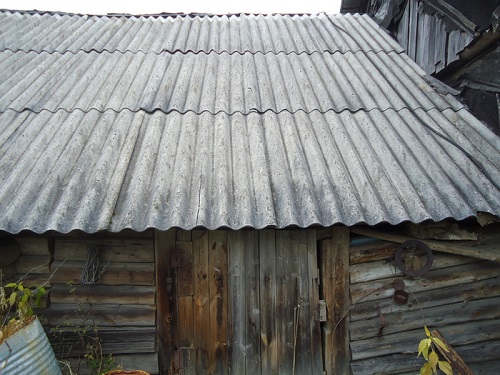
Cement tile also includes all the characteristics of ceramic, only its durability is an order of magnitude lower. Cement tile is formed by reaction in the process of setting cement-sand mortar under strong pressure. It is profile and flat, with and without glaze. Application slope in the range of 20-60 degrees. Its main advantages: resistance to solar radiation and aggressive environments, as well as frost resistance. The main disadvantages: massive relative to ceramic, a large percentage of scrap during transportation, high cost. From a decorative point of view, it looks the same as a ceramic one, it only costs less, but it differs in terms of quality.
Mineral roofing materials are also represented by classic slate.Small sawn tiles made of natural stone have an almost unlimited service life. Slate is also distinguished by its lightness and very high price.
In the group of piece materials, not so long ago, a new representative of porcelain tile appeared, which has firmly taken its position in the construction market due to its strength, durability and aesthetics. But this material also has a relatively high price.
Different types of bituminous-mastic roofing materials have almost the same properties as their rolled counterparts, the main difference is a rather large slope. These materials are easy to repair and light in weight. Bituminous tiles are made of cellulose or fiberglass, polyester, which are applied to a special tile. At the end, the tile is covered with a special substance that paints it in the required color. It is mainly used for garages, gazebos, cottages, houses and public buildings in the case of an irregular roof shape.
Among the advantages: the possibility of quick and inexpensive local repair, sound insulation, the material is not susceptible to rust, rot and corrosion, does not break during installation or transportation. Among the disadvantages: not the naturalness of the material, high combustibility and fading in the sun, as well as the inability to carry out installation work in the winter.
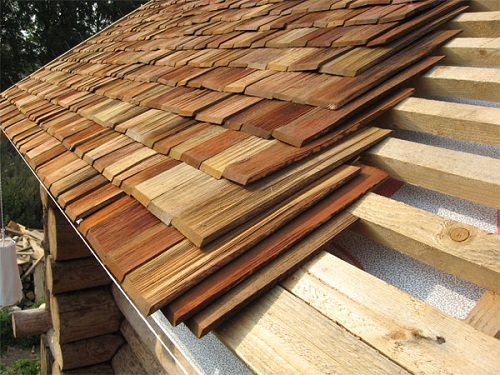
In a separate group allocate materials from wood. Among them you can see wood chips, shingles and shingles. Their main differences: lightness, durability and high cost. Such materials for the roof must be laid especially carefully.
You can also find a coating of straw and reeds. Such natural materials create a “healthy” microclimate in the house, because they allow it to “breathe”.
All roofs made from natural materials can be distinguished into a special category. They are more suitable for hotels, hotels, bars and restaurants, creating a special atmosphere. In addition, they are environmentally friendly and look exclusive.

Under such a roof, it is necessary to lay a layer of waterproofing. Also, in order for the roof to be "warm", it is necessary to lay a heater.
Each type of small-piece roofing materials is stacked in one of two ways:
- continuous;
- on a very frequent crate.

It is better to start installation from one of the lower corners of the roof. Natural and artificial stone are fixed together using special curly elements. The euro tile is fixed with nails to the top of the plate.
Laying is carried out in rows. The edges of the roof, the end and connections to the roof equipment are made using special elements from the same material, or from roofing iron.
Bulk roof
Bulk roof - a separate type of roof with a special material.
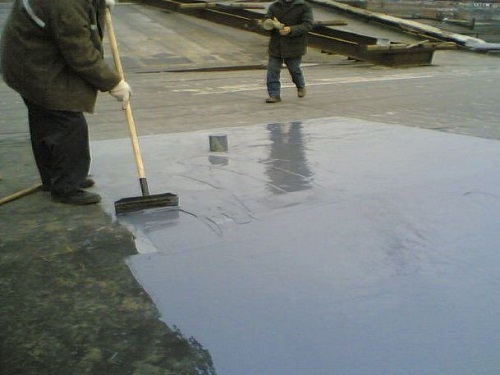
Bulk roofing is a complete roofing system, which includes a waterproofing polymer composition, a primer or primer, a protective coating (usually a fine-grained granulate due to its high resistance to ultraviolet light), a filler for chemically resistant coatings, plasticizers (in case of work at low temperatures )
Self-leveling roofs are classified as polymer membranes that are applied to the roof. By composition, such membranes are divided into polymer-rubber and polymer.
The main differences of the bulk roof:
- at least 15 years service life;
- decorativeness due to a wide color spectrum;
- wear resistance and durability;
- lack of seams;
- resistance to decay and ultraviolet;
- ease of application.
But do not forget that this is not a natural material with a fairly high price.
When choosing a roof, do not forget to consult with the supplier or manufacturer of the materials regarding the quality, guarantees, delivery options and installation supervision. It will not be superfluous to communicate with the architect about the possibilities of using this or that material that has attracted your attention, its design and the required quantity.

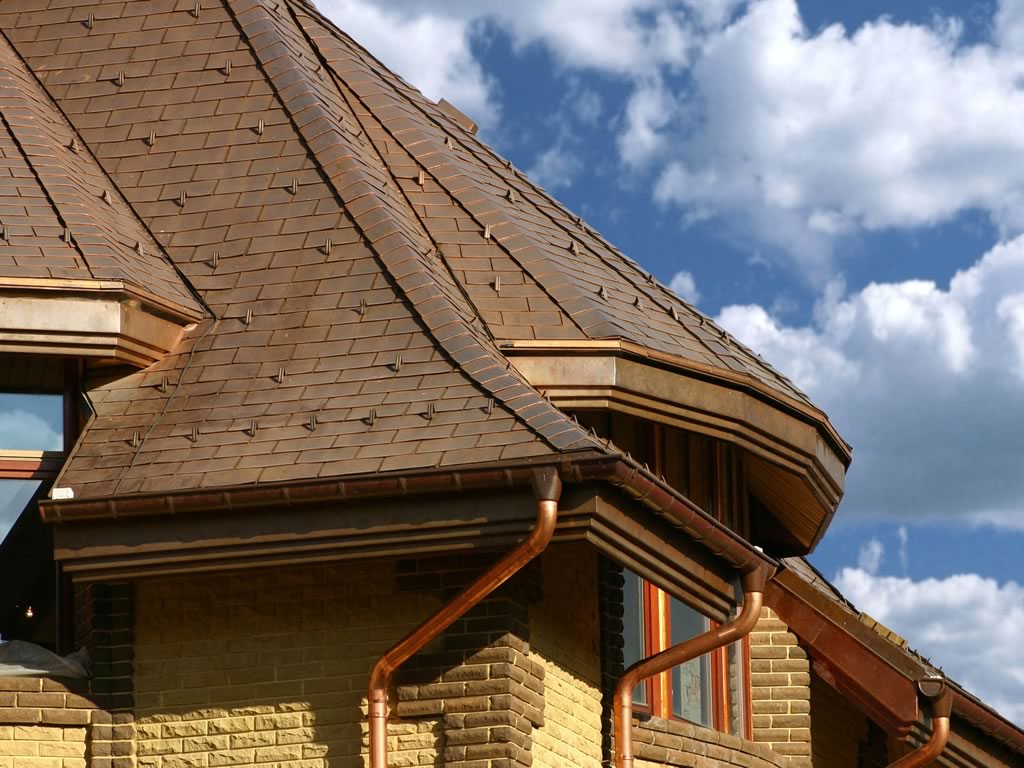



Alas, no comments yet. Be the first!